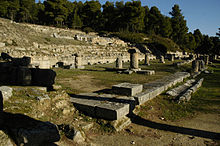Stoa
Appearance move to sidebar hide The restored Stoa of Attalos in Athens, with busts of historical philosophers.
The restored Stoa of Attalos in Athens, with busts of historical philosophers.
A stoa (/ˈstoʊə/; plural, stoas, stoai, or stoae /ˈstoʊ.iː/), in ancient Greek architecture, is a covered walkway or portico, commonly for public use. Early stoas were open at the entrance with columns, usually of the Doric order, lining the side of the building; they created a safe, enveloping, protective atmosphere.
This, an "open-fronted shelter with a lean-to roof", is the meaning in modern usage, but in fact the ancient Greeks "made no clear distinction in their speech" between these and large enclosed rooms with similar functions.
Later examples were built as two stories, and incorporated inner colonnades usually in the Ionic style, where shops or sometimes offices were located. These buildings were open to the public; merchants could sell their goods, artists could display their artwork, and religious gatherings could take place. Stoas usually surrounded the marketplaces or agora of large cities and were used as a framing device.
Other examples were designed to create safe, protective atmospheres which combined useful inside and outside space. The name of the Stoic school of philosophy derives from "stoa".
Famous stoas
 View of the Stoa Amphiaraion
View of the Stoa Amphiaraion
- Stoa Poikile, "Painted Porch", from which the philosophy Stoicism takes its name
- Stoa of Attalos
- Stoa Basileios (Royal Stoa)
- Stoa of Zeus at Athens
- Stoa Amphiaraion
- Stoa of the Athenians
- Royal Stoa of Herod's Temple
See also
References
- ^ a b "stoa", Oxford English Dictionary, 2nd Ed., 1989
- ^ "stoa". Retrieved 2010-12-29.
- ^ Baltzly, Dirk (2019), "Stoicism", in Zalta, Edward N. (ed.), The Stanford Encyclopedia of Philosophy (Spring 2019 ed.), Metaphysics Research Lab, Stanford University, retrieved 2021-10-22
- ^ Lawrence, 252
- ^ Jeffrey Becker. "Introduction to Greek architecture". Khanacademy.org. Retrieved 10 March 2016.
- ^ Sedley, David (2016), "Stoicism", Routledge Encyclopedia of Philosophy (1 ed.), London: Routledge, doi:10.4324/9780415249126-a112-1, ISBN 978-0-415-25069-6, retrieved 2021-10-22
- Lawrence, A. W., Greek Architecture, 1957, Penguin, Pelican history of art
External links
- YASOU
- "Stoa" . Encyclopædia Britannica (11th ed.). 1911.
| Authority control databases: National |
|---|